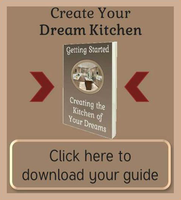We’ve written in the past that function trumps form in kitchen design – and that’s t rue in many ways. When it comes to the form aspect of the puzzle, we think of the kitchen in terms of an artistic composition, and this composition includes things like a united, harmonious theme, focal point(s) balance, symmetry, contrast…and texture!
rue in many ways. When it comes to the form aspect of the puzzle, we think of the kitchen in terms of an artistic composition, and this composition includes things like a united, harmonious theme, focal point(s) balance, symmetry, contrast…and texture!
Are Textures Balanced in Your Chicago Kitchen Design?
Texture keeps things from getting too one-dimensional, adding interest and contrast with other fetaures and finishes. Some kitchen designs require more emphasis on texture than others. For example, traditional kitchen designs tend to be “texture rich” because fancier wood trim and an emphasis on furniture-like features automatically add texture to the mix.
On the other side of the coin are modern or ultra-contemporary designs, which can wind up looking so linear and sleek, they wash out. These are the design styles that often benefit most from a texture check and adjustment.
5 Ideas for Ensuring Your Design Has Interesting Texture Dynamics
Not sure if the textural component is interesting enough in your kitchen? Here are 5 ideas for upping the texture ante.
Create a dynamic backsplash
The backsplash is a fun way to add artistic flair and texture into a kitchen. Mosaic patterns, additions of metallic elements, a colorful array of glass tiles and other texturally-rich backsplash options are a great way to add texture. You can use this theme for the entirety of the backsplash, or make the backsplash a focal point behind the stovetop, or to showcase your tea or coffee bar.
Opt for stained cabinets that show off wood grains
Wood grains have both texture and motion, a double-win. You don’t have to use them for the entirety of your kitchen. In fact, this Highland Park Contemporary Kitchen is a perfect example of how exotic Macassar cabinet veneers, and sleek, glossy, flat-panel cabinets were combined for a stunning effect. Had the homeowners insisted on all-white cabinetry, the kitchen would have had a flat, boring effect. The contrast of an exotic wood added attractive texture and character.
You don’t have to use an exotic wood to do this, choosing cabinets with rift or quarter-sawn wood can increase the appearance of a classic cabinet wood by altering the way grains show up when compared with the standard plain sawn methods, which yield consistent grain patterns.
Textured (or textured-looking) cabinet finishes
The cabinet finish you select is another way to bring texture into the mix. Something as simple as a glazed finish adds subtle texture, highlighting cabinet door contours. Distressed, crackled and brush-stroke finishes also add noticeable textural notes.
Choose a pattern-rich slab
Bold patterns are another way to gain textural boosts. Those multi-colored or larger, mineral flecked granite and quartz slabs will do this for you. Countertop edge details can also add more dimension. If there’s a highly-patterned slab you like, but you fear it’s too much for the entire kitchen, think about using more than one countertop option for both textural and contrast benefits.
Moulding and wood details
Crown moulding around the ceiling, bead-board, corbels – all are examples of wood details that add textural and dimensional punch. While often associated with traditional kitchens, there are wood details for every style preference and your Chicago kitchen designer will help you identify the best options for your space.
Visit Kitchens & Baths Unlimited to glean more professional tips on how to add texture to your luxury Chicago kitchen design.



